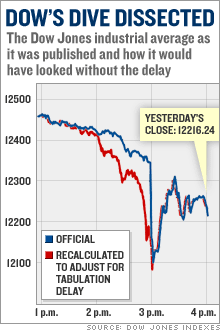The Dow's technical glitch, dissectedPublisher expects normal operations on back-up system, but still looking for root cause of Tuesday's glitch.NEW YORK (CNNMoney.com) -- Dow Jones offered a more detailed explanation Wednesday about why its industrial average took a nosedive during the market selloff Tuesday, but said it was still looking into what caused the problem. Dow Jones (Charts) Indexes also said it was still running on the backup system it reverted to Tuesday afternoon and expects normal readings for the DJIA Wednesday, though it's still working to correct the root cause.  The publisher of the Dow industrials said that a system problem starting at 1:50 p.m. ET on Tuesday, amid unusually heavy trading volume, caused a 70-minute lag during which the value of the market measure lagged the declines in the underlying stocks. The subsequent downward spike in the Dow occurred when the problem was corrected as the company switched to its backup system at around 3 p.m. Just before the switch, the Dow was showing about a 160-point drop. But then the blue-chip barometer appeared to tumble some 200 points in the blink of an eye as the newly available data was correctly reflected in the average. That drop then sparked nervousness among traders and the Dow fell another 100 points or so, eventually ending down 416, its seventh-biggest point decline ever. What happened over a short period of time should have happened over a longer period, explained a Dow Jones spokeswoman. "To see the market drop hundreds of points out of nowhere was alarming, to hear that it was a technical glitch really pissed people off," said Peter Boockvar, chief equity strategist at Miller Tabak & Co. Michael Petronella, the president of Dow Jones Indexes, said there was a problem with the system that feeds market data into the calculation system. While the DJIA was still being calculated and disseminated, the calculator was not receiving the underlying prices for the 30 stocks in the Dow on a timely basis. Once the slow data feed problem was recognized, Dow Jones Indexes switched to a back-up system, causing prices to be adjusted all at once, bringing the index immediately in line with its underlying component stocks. That led to the big 200-point drop. Petronella said all Dow Jones indexes are backed up, which is what enabled the DJIA to move to another system with timely pricing. Meanwhile, the New York Stock Exchange (Charts) said separately that the high volume of traffic in certain Dow components and tangentially related stocks caused a late-day slow down. Because of the backlog, some traders were forced to use paper tickets to execute trades and some trades did not go through. "We had orders that were entered into the system that weren't executed," Boockvar said. "I didn't hear until 4:00 p.m. that I didn't get anything." "Yesterday there was problem with the Dow Jones' calculations (and) we had some subsequent problems," an NYSE spokesman said Wednesday. Technicians worked overnight to readjust the NYSE's trading capacity and are continuing to look at it today, according to a spokesman. The Dow's loss Tuesday was its biggest point decline since Sept. 17, 2001, the first trading day after the Sept. 11 attacks. By midsession Wednesday the Dow was up about 0.7 percent. |
|
